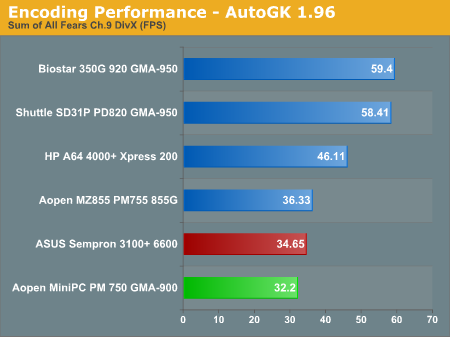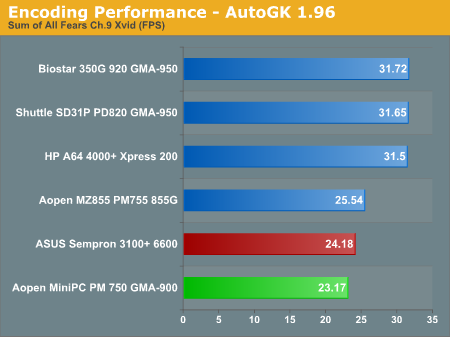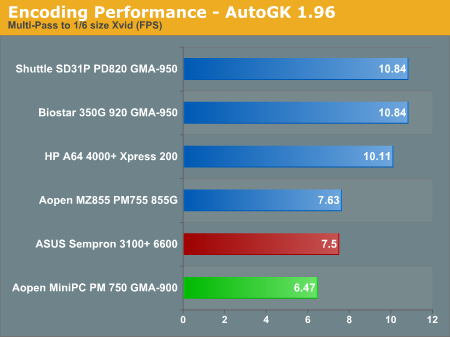Updated: AOpen MiniPC – Imitation is the Sincerest Form of Flattery
by Jarred Walton on March 3, 2006 12:05 AM EST- Posted in
- Systems
Encoding and Multimedia Benchmarks
Using AutoGK, we tested the multimedia encoding capabilities of the systems. For HTPC use, we tested the playback of several different video files as well and checked CPU use. For video playback, we used DVI as well as component output running 720p resolutions. We also tested performance connected to a Dell 2405FPW running at the native 1920x1200 resolution of the display, as video scaling can increase the load on the system for video content. The Pentium 4 506 chip had some issues during testing, so unfortunately, we didn't get AutoGK results with it.
DivX and Xvid encoding are good enough for casual use, but clearly, the Pentium M chip is not as fast as other platforms. Even the lowly Sempron 3100+ outpaces the Pentium M 740, though the margin is relatively close. Running a Core Duo processor would help quite a bit, but even that wouldn't catch up with Pentium D or Athlon X2 performance. For multimedia creation, the MiniPC is probably too slow for serious work. However, if you just want to encode the occasional video clip, letting the system process the file overnight will get the job done before you wake up in the morning. WMV9HD encoding is a different matter, but that's slow even on the fastest dual core systems.
Video Decoding
If you have a second PC doing the encoding work, the MiniPC works quite well as an HTPC. For video playback, there won't be any graphs, but I instead focused on the overall experience. Lower demand playback like MPEG-2 isn't even remotely a problem, so let's move on to the more demanding tasks.
Playing back 720p and 1080i content - even with scaling the video to fill the screen - worked without a hitch, with the CPU running a maximum of 50-80% load. (We'll talk a bit more about 1080i content later.) Every now and then, you might see a slight skip, most likely caused by another application using the hard disk, but otherwise, HDTV content worked fine. DivX and Xvid playback presented no difficulties either, with CPU load for both under 25% at typical (720x480) resolutions. DivXHD used more CPU time for the higher resolution, but playback still only used about 50% of the CPU power.
The other systems were all equal to the MiniPC or substantially better, but the bottom line is that for the currently most common video formats, all of the tested systems handled MPEG-2/HD/DivX/Xvid video playback with enough CPU power left in reserve that stutters shouldn't be a problem. Multitasking might present problems on the slower systems, of course, so we wouldn't recommend trying dual display output on the MiniPC with one display showing an HDTV stream, if you're trying to get work done, but few people really do that in our experience.
WMV9HD is a different story, but we've come to expect that from our most brutal video playback tests. 720p was okay, though it sometimes struggled (hitting upwards of 80% CPU usage); basically, it ran about as well as a 1080i HD transport stream. 1080p on the other hand was essentially unwatchable. Dual cores and even GPU acceleration are pretty much required to get completely smooth WMV9HD support for 1080p content; even a fast Athlon X2 or Pentium D will struggle with 1080p WMV9HD decoding, unless the GPU offloads some of the work. As nice as WMV9HD looks, it's difficult to justify the performance requirements at this time. DivXHD files encode and decode with much less CPU power, and file sizes are pretty comparable. As long as you stick to the other less CPU intensive codecs, the MiniPC will work fine.
Using AutoGK, we tested the multimedia encoding capabilities of the systems. For HTPC use, we tested the playback of several different video files as well and checked CPU use. For video playback, we used DVI as well as component output running 720p resolutions. We also tested performance connected to a Dell 2405FPW running at the native 1920x1200 resolution of the display, as video scaling can increase the load on the system for video content. The Pentium 4 506 chip had some issues during testing, so unfortunately, we didn't get AutoGK results with it.




DivX and Xvid encoding are good enough for casual use, but clearly, the Pentium M chip is not as fast as other platforms. Even the lowly Sempron 3100+ outpaces the Pentium M 740, though the margin is relatively close. Running a Core Duo processor would help quite a bit, but even that wouldn't catch up with Pentium D or Athlon X2 performance. For multimedia creation, the MiniPC is probably too slow for serious work. However, if you just want to encode the occasional video clip, letting the system process the file overnight will get the job done before you wake up in the morning. WMV9HD encoding is a different matter, but that's slow even on the fastest dual core systems.
Video Decoding
If you have a second PC doing the encoding work, the MiniPC works quite well as an HTPC. For video playback, there won't be any graphs, but I instead focused on the overall experience. Lower demand playback like MPEG-2 isn't even remotely a problem, so let's move on to the more demanding tasks.
Playing back 720p and 1080i content - even with scaling the video to fill the screen - worked without a hitch, with the CPU running a maximum of 50-80% load. (We'll talk a bit more about 1080i content later.) Every now and then, you might see a slight skip, most likely caused by another application using the hard disk, but otherwise, HDTV content worked fine. DivX and Xvid playback presented no difficulties either, with CPU load for both under 25% at typical (720x480) resolutions. DivXHD used more CPU time for the higher resolution, but playback still only used about 50% of the CPU power.
The other systems were all equal to the MiniPC or substantially better, but the bottom line is that for the currently most common video formats, all of the tested systems handled MPEG-2/HD/DivX/Xvid video playback with enough CPU power left in reserve that stutters shouldn't be a problem. Multitasking might present problems on the slower systems, of course, so we wouldn't recommend trying dual display output on the MiniPC with one display showing an HDTV stream, if you're trying to get work done, but few people really do that in our experience.
WMV9HD is a different story, but we've come to expect that from our most brutal video playback tests. 720p was okay, though it sometimes struggled (hitting upwards of 80% CPU usage); basically, it ran about as well as a 1080i HD transport stream. 1080p on the other hand was essentially unwatchable. Dual cores and even GPU acceleration are pretty much required to get completely smooth WMV9HD support for 1080p content; even a fast Athlon X2 or Pentium D will struggle with 1080p WMV9HD decoding, unless the GPU offloads some of the work. As nice as WMV9HD looks, it's difficult to justify the performance requirements at this time. DivXHD files encode and decode with much less CPU power, and file sizes are pretty comparable. As long as you stick to the other less CPU intensive codecs, the MiniPC will work fine.










54 Comments
View All Comments
davecason - Friday, March 17, 2006 - link
Just an FYI for the reviewer: use tweezers. The plastic inner shell is designed for tweezers with an angled grip point. There are both cut-outs and spaceous slotting to accomodate tweezers on every screw installation.Did anyone pick up one of these and have trouble with the IDE PCB? I have two problems: 1) DMA turns itself off and the drive resorts to PIO mode when I attach it through to the PCB. I have tested the drive elsewhere and on the USB bus and it runs at normal speeds but when it is attached internally it slows down to about 1/10 of the speed. Removing the optical drive from the PCB has no affect on the problem.
2) The system hiccups when I boot it. The optical drive goes into a long series of IDE bus restarts and if I remove it, the IDE drive simply takes forever to boot (probably because of some bus error and the speed is being backed down to almost nothing).
Any suggestions for that?
davecason - Tuesday, March 28, 2006 - link
The IDE bus was restarting itself due to a power problem. I had the following plugged into the USB bus:1) USB Keyboard with USB hub with a USB mouse plugged into it.
2) USB bus-powered hub with a self-powered PDA base and a UPS plugged into it.
I removed #2 and the IDE bus began functioning normally. I guess four/six items on the USB bus was too much power draw from the system. If you experience this, get a self-powered USB hub.
Plugers - Saturday, March 4, 2006 - link
On the next revision.Add a upgradable laptop video card slot. If laptops can get a nice small Nvidia / ATI solution, why not this? Also add the other audio port, or just add a toslink for HTPC use and I think most of the high end PC sound systems have a digital input option anyway.
throw in another sodimm slot while your at it....
bldckstark - Saturday, March 4, 2006 - link
I am glad to see that for once there are not many whiny posts about the comparison systems. Thanks for the inclusion of the Sempron system.Kishkumen - Saturday, March 4, 2006 - link
Actually my interest with these Mini PCs whether Aopen or Apple is to use them as a lightweight frontend to a Linux/MythTV HTPC with storage and encoding duties relegated to a master backend and better yet no need to whine about the additional cost of an OS. The mini is small enough that it can be easily attached to the back of a plasma or LCD for a very clean look. That said, Aopen's audio solution is absolutely tragic. I really don't understand how they thought they could skimp in this area even if they were completely unaware of it's potential as a HTPC solution. At the very least a digital optical connector should have been included. Thus I'm inclined to go with the Apple solution on the audio issue alone, but in general it seems like the better hardware and I have no reason to believe I can't run Linux on it just fine. I'll be paying for an OS I don't need but maybe I can just pawn it off on ebay or I'll just keep it around for the halibut. Something to gape at once in a while like a two headed snake in a jar at the circus.JarredWalton - Saturday, March 4, 2006 - link
Does Linux run on EFI okay? I don't have any idea. It's certainly a lot more likely than XP on EFI. Anyway, the MP945 is supposed to go with at least 5.1 audio I think.mindless1 - Saturday, March 4, 2006 - link
PLEASE, quite trying to pretend Apple is some kind of leader in form factor. no, it was not the MAC cube that started SFF. This AOPEN is not imitation anything either. Did you really think the entire computer world was NOT moving towards high integration and as-small-as-possible systems?It had absolutely nothing to do with Apple. Apple merely did the same as everyone else, sometimes coming up with a particular niche product sooner than others, and sometimes later than others. The one most noteworthy thing apple did was advertising.
How about the ipod? It wasn't first either. Good grief, why in the world do you have an arbitrary false conclusion that apple was first at much of anything?
That's not to downplay Apple's influence, they did add a certain esthetic appeal, more artistic cases on many products. That's not what was implied in the article though...
JAS - Monday, March 6, 2006 - link
Just a general comment:MAC = Media Access Control, as in a computer's Ethernet address
Mac = shorthand for Macintosh
JarredWalton - Saturday, March 4, 2006 - link
By your reasoning, Apple was first at nothing, and the only first was probably the ENIAC. After all, we've just been moving to smaller computers for over 60 years now.... Seriously, there is no way you can convince me that the AOpen MiniPC wasn't an attempt at copying the Mac Mini design. Was the Mac Mini completely original? Maybe someone had something like that before, but they're the ones that really put the "Mini" computers on the map.Anyway, how about some comparisons from AOpen - nice pictures, and they clearly show that any resemblance to the Mac Mini is likely more than coincidence.
http://images.anandtech.com/reviews/system/sff/aop...">MiniPC vs. Mac Mini #1
http://images.anandtech.com/reviews/system/sff/aop...">MiniPC vs. Mac Mini #2
http://images.anandtech.com/reviews/system/sff/aop...">MiniPC vs. Mac Mini #3
http://images.anandtech.com/reviews/system/sff/aop...">MiniPC vs. Mac Mini #4
http://images.anandtech.com/reviews/system/sff/aop...">MiniPC vs. Mac Mini #5
psychobriggsy - Saturday, March 4, 2006 - link
The Mac Mini looks better, both in terms of looks and design (e.g., the back panel looks so much better). If you're gonna copy a design, at least try and make it look even better if you're not going to compete on price...